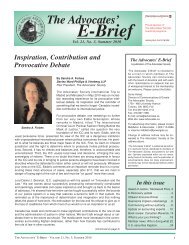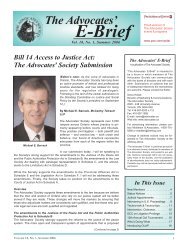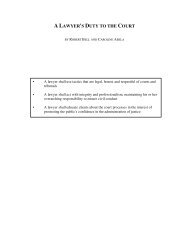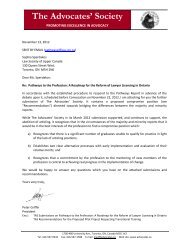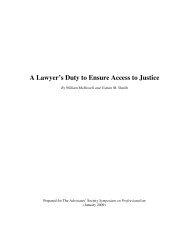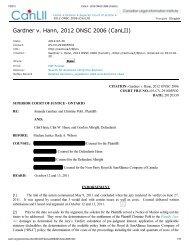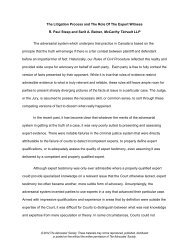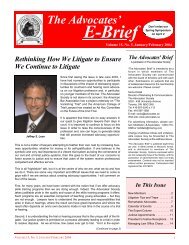History Cover & Text.qxp - The Advocates' Society
History Cover & Text.qxp - The Advocates' Society
History Cover & Text.qxp - The Advocates' Society
Create successful ePaper yourself
Turn your PDF publications into a flip-book with our unique Google optimized e-Paper software.
question, noted American consumeradvocate Ralph Nader was bookedfor a presentation and a videotapeof his appearance was sent to allmembers of the NDP caucus,amongst others.<strong>The</strong> Spring Convention chaired byBert Raphael was held in Rome andVenice. At the CanadianEmbassy to the Vatican,members were greeted bythe Ambassador, who waspresent throughout the lecturesand discussions.Although the 1992-93 termwas as full as ever, there weretwo issues that still managedto dominate proceedingsduring the administration ofPresident Eleanore A. Cronk.<strong>The</strong> first issue was <strong>The</strong> <strong>Advocates'</strong><strong>Society</strong> Institute. Although it certainlyhad found its legs, its financesstill were not on solid footing.Following the resignation of RuthWindeler early in the term, the ASIhired Nancy E. Reason as its newDirector. Ms Reason came to the<strong>Society</strong> with a background in bothlaw and education, and she wouldmore than fulfil her challenge tosteer the Institute to sound financialground. It was at this time that theInstitute adopted the teachingmethodology created by theNational Institute for TrialAdvocacy of Notre Dame LawSchool (NITA), a learning-by-doingtechnique, and Ms Reason wasinstrumental in the success of thistransition. <strong>The</strong> Institute wasrenamed the Ontario Centre forAdvocacy Training, to better reflecta renewed commitment to delivercomprehensive advocacy trainingthroughout the province.<strong>The</strong> second issue was the levy forCampbell House, which had turnedinto much more of an exercise thanthe <strong>Society</strong>'s Directors could everhave imagined. Of the 1,700 members,approximately two-thirds hadcontributed by September 1992, butRoger G. Oatley assumed the presidencyfor the 1993-94 term. Duringhis administration, $17,000 was allocatedto furnish the <strong>Society</strong>'s administrativearea in the third-flooroffices at Campbell House, and along-overdue redecoration of thedining room was begun. OCAT wasstill experiencing minor cash flowproblems, but the addition to its calendarof advocacy training for crimfully483 had not. This represented ashortfall of about $150,000, moneythat already had been spent on renovationsand that, therefore, had tobe taken from the <strong>Society</strong>'s surplusfunds. <strong>The</strong> situation brightened,however, and by November 1993, allbut 18 members had paid the firstinstalment of their levy.<strong>The</strong> Spring Convention chaired by BertRaphael was held in Rome and Venice. Atthe Canadian Embassy to the Vatican,members were greeted by the Ambassador,who was present throughout the lecturesand discussions.Early in 1993, the <strong>Society</strong> struck anIntervention Committee to considerand recommend interventionswhere requests were made. <strong>Society</strong>members unfailingly responded torequests to act as counsel, pro bono,when the Board of Directors acceptedan intervention recommendation.Although the <strong>Society</strong> wouldseek to intervene in very few proceedings,its involvement wouldinvariably be welcomed by theBench. In Essa v. Guergis (1993), theHonourable Justice Joseph O'Briendescribed the <strong>Society</strong>'s interventionas "…most helpful…<strong>The</strong> intervention…wasmost useful to the Courtand is an excellent example of thebenefits from intervention in propercases."One of the highlights of this termrevolved around a meeting with theHonourable Chief Justice Charles L.Dubin, during which he revealedthat he was becoming increasinglyconcerned with a perceived loss ofstatus and prestige of the judiciaryand the judicial system, and that hefeared that self-governance mightbe in jeopardy unless respect for thesystem was restored. PresidentCronk acted on the Chief Justice'sfears in two ways. Firstly, she hadhis remarks summarized and dis-20tributed to the <strong>Society</strong>'s membership.Secondly, the <strong>Society</strong> sponsoreda meeting in Sudbury thatwould have the dual purpose of notonly giving the Chief Justice a platformfor his concerns, but also incidentallyhelping to raise the<strong>Society</strong>'s profile in the area.<strong>The</strong> <strong>Society</strong> continued itsefforts with the ongoinginsurance question, the proposedEnvironmental Bill ofRights, the review of theOntario judicial system, andthe issue of the review andpotential restructuring of theprovince's Legal Aid program.<strong>The</strong> <strong>Society</strong> also beganto watch carefully the ColeCommission on SystemicRacism in the Ontario justicesystem.From April 29 to May 1, 1993, the<strong>Society</strong> once again took to theboards in another fund raising collaborationwith <strong>The</strong> Canadian StageCompany, titled "<strong>The</strong> Caine MutinyCourt-martial." Box office receiptsfor the <strong>Society</strong> totalled some$40,000. In a pair of notable firsts, areception was held in London inMay to familiarize female advocateswith the mandate and objectives ofthe <strong>Society</strong>, and to invite applicationsfor membership. And the<strong>Society</strong> ended the term with not onebut two End of Term Dinners: one inOttawa, with the Honourable JusticeJohn Major of <strong>The</strong> Supreme Court ofCanada as guest speaker, and one inToronto, with the HonourableMarion Boyd, Attorney General forOntario, as guest speaker.



